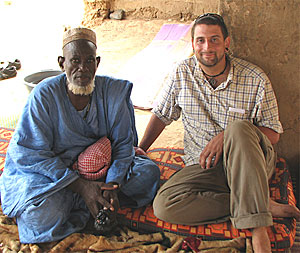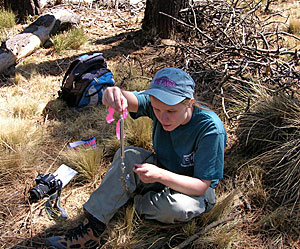They're measuring mercury levels in Botswanian waters, researching early 20th century Arab newspapers in Syria, analyzing ways to improve rice production in Senegal, and much more.
UC Santa Cruz had eight Fulbright Program grantees in 2007-08--a feat it's only accomplished twice before in the past 15 years, and a higher ratio of accepted candidates versus applicants than many prominent private universities. UCSC had only 14 applicants to the public diplomacy program; Princeton University, which also claimed eight scholarship recipients, had 57 applicants.
"We just had outstanding students with exceptional projects," said Marlene Robinson, undergraduate honors and awards coordinator for the campus. "We are delighted that so many of our students were chosen for this wonderful opportunity. We know they will be outstanding ambassadors for our institution and for the United States."
Students apply and interview with a Fulbright committee on their home campus. Nominations then go to Fulbright headquarters, which sends the best proposals to the host country. The host country then makes its selections, said Robinson.
The UCSC Fulbright Review Committee members were Buchanan Sharp, professor of history and faculty director of the Education Abroad Program; Lani Giovanetti, former director of International Scholar and Student Services; and Robinson.
The eight Fulbrighters are:
- Elizabeth Bastiaans, who is studying a threatened lizard in Mexico;
- Frank Black, who is measuring mercury levels in water, fish, and hair of subsistence fishermen in Botswana;
- James Casey, who is conducting research on early 20th century Arab newspapers in Syria;
- Timothy Krupnik, who is researching farming systems to improve rice production and natural resource conservation in Senegal;
- Michelle Olsgard, who is investigating the sustainability of a fungus important to Chinese traditional medicine on the Tibetan Plateau;
- Elizabeth Orr, who is studying the impact of global warming on insect populations in Sweden;
- Leah Samberg, who is researching the effects of a rapidly growing population on the biodiversity and sustainability of the agroecosystem of the Ethiopian highlands;
- Anna Zivian, who is addressing the growing trend of environmental policy and politics being contested at the local level in Austria.
Fulbrighters act as students, scholars, teachers, lecturers, researchers, mentors, artists, philanthropists, cultural ambassadors, and advocates.
| The Fulbright U.S. Student Program
More than 1,450 U.S. citizens will travel abroad for the 2008-2009 academic year through the Fulbright U.S. Student Program. America's flagship international educational exchange program, Fulbright is sponsored by the United States Department of State, Bureau of Educational and Cultural Affairs. Since its establishment in 1946 under legislation introduced by the late Senator J. William Fulbright of Arkansas, the Fulbright Program has provided approximately 286,500 people--108,160 Americans who have studied, taught, or researched abroad and 178,340 students, scholars, and teachers from other countries who have engaged in similar activities in the United States--with the opportunity to observe each others' political, economic, educational, and cultural institutions, to exchange ideas, and to embark on joint ventures of importance to the general welfare of the world's inhabitants. The program operates in more than 155 countries worldwide.
|
Bastiaans, who grew up in Ames, Iowa, is sampling a number of populations of lizards in central Mexico to look for variation in a throat-color polymorphism that she thinks may be a marker for a mating strategy polymorphism, as her advisor, Barry Sinervo, has found in two other species of lizards.
James Casey, 21, of Sonoma, is working at the Center for Historical Documents in Damascus, doing research on the facility's extensive collection of early 20th century Arab newspapers. He is looking at contrasting accounts in the popular press of several key moments in the early years of the French Mandate. He's also taking Arabic classes at the University of Damascus.
"As there is relatively little scholarship on the Syrian popular press during the French Mandate and even less that examines popular political sentiments in the press, the potential for uncovering new information about the Mandate is significant," wrote Casey from Damascus.
Tim Krupnik, 32, who is originally from Indiana, Penn., is researching low-external input rice production and improving resource use efficiency in rice farming in Senegal.
"My work has been extremely challenging, as research always is, but conducting detailed work in a second language is always double the difficulty," wrote Krupnik from Senegal. "Nonetheless, it is also twice an accomplishment when things work and your results begin rolling in."
With the Fulbright, he wrote, "I have been able to deepen my research in ways I had not expected to, and I have branched out and am now conducting more locally relevant side studies on the ecology of rice production in Northern Senegal."
Lisa Orr, 26, of South Lake Tahoe, is living in Lund, Sweden, studying the impact of global warming on insect populations with Dr. Erik Svensson of Lund University.
"My research is going very well," Orr wrote from Lund. "I'm currently raising over 1,000 damselfly larvae in two temperature treatments and tracking their growth rate individually (quite an intense setup!). This fits into my original research goal, but since I've been here the direction of my research has evolved and I will hopefully be working on damselfly vision this summer as well as some molecular work."
Zivian, 41, of Telluride, Colo., is in Austria examining the trend of turning to local government as a new strategy of environmental mobilization.
"I'm enjoying being in Austria and meeting with scholars and interview subjects for my research," Zivian wrote from Austria. "The most important thing I have learned so far, as far as my research goes, is how in sync all levels of Austrian society--from local politicians to citizens to activists to farmers to national politicians--are in terms of their opposition to genetically modified organisms."
The Fulbrighters all spoke earnestly of their research goals, their progress, and their academic accomplishments. But there are other things to experience while they're abroad, too.
Casey, in Syria, plans to travel, taking the Torsos Express, the train from Aleppo, Syria, to Istanbul on which Agatha Christie's Murder on the Orient Express begins.
Orr, in Sweden, described gamely trying the Swedish delicacy surströmming (canned fermented Baltic herring): "After a surströmming party, everyone is going to smell of rotten fish regardless of who opened the can."
And for Krupnik, being in Senegal has not been without its setbacks and surprises.
"There is always the bouts with salmonella poisoning and the quirky tropical illnesses that come with lots of time in the field," he wrote, "or the time when my truck broke down in the middle of nowhere and I hitched a ride back to the nearest village on the back of a farmer's donkey."




